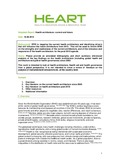| dc.contributor.author | Thompson, Stephen | |
| dc.date.accessioned | 2020-09-03T12:56:26Z | |
| dc.date.available | 2020-09-03T12:56:26Z | |
| dc.date.issued | 2014-08-18 | |
| dc.identifier.citation | Thompson, S. (2014) 'Health Architecture: Current and Future', Helpdesk Report, HEART | en |
| dc.identifier.uri | https://opendocs.ids.ac.uk/opendocs/handle/20.500.12413/15608 | |
| dc.description.abstract | Since the World Health Organization (WHO) was established over 60 years ago, it has been at the centre of global health governance. HoLIGOC 2008 The WHO’s political legitimacy exists because its membership encompasses all countries in the UN. This allows WHO to convene governments and other players to negotiate rules, resolve differences, and reach consensus. Sridhar et al 2014 Member states are also major players, but with varying degrees of influence and involvement. Hoffman & Røttingen 2014 Nonstate actors involved include private foundations, civil society groups, academics, research institutes, global social movements, private companies, private philanthropists, consultancy firms, think tanks, religious movements and even organized crime. Dodgson et al 2002, Szlezák et al 2010 | en |
| dc.language.iso | en | en |
| dc.publisher | The Health & Education Advice & Resource Team (HEART) | en |
| dc.rights.uri | http://creativecommons.org/licenses/by/4.0/ | en |
| dc.subject | Health | en |
| dc.title | Health Architecture: Current and Future | en |
| dc.type | Helpdesk | en |
| dc.rights.holder | © HEART | en |
| rioxxterms.funder | Default funder | en |
| rioxxterms.identifier.project | Default project | en |
| rioxxterms.version | NA | en |
| rioxxterms.funder.project | 9ce4e4dc-26e9-4d78-96e9-15e4dcac0642 | en |


